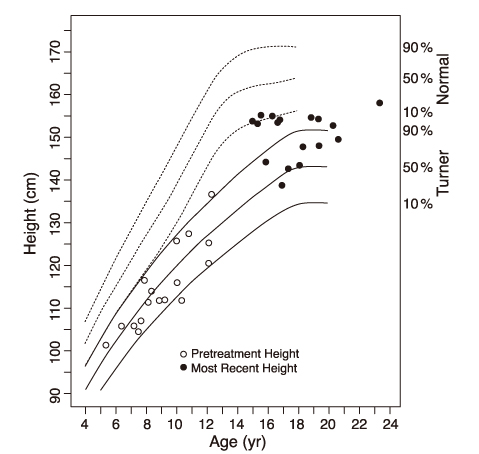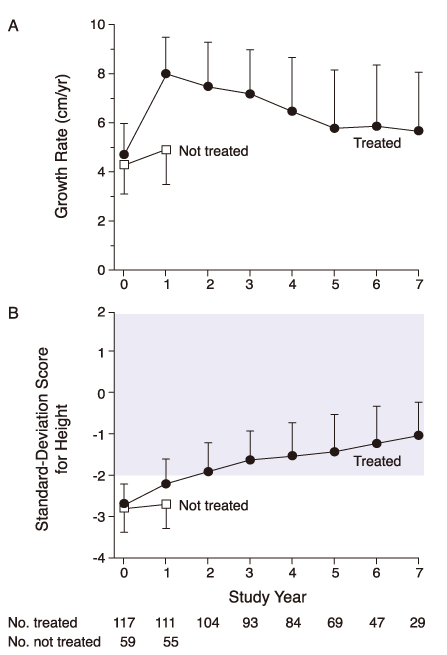J Korean Med Assoc.
2008 Sep;51(9):849-855. 10.5124/jkma.2008.51.9.849.
Growth Hormone Therapy in Short Stature Children
- Affiliations
-
- 1Department of Pediatrics, Korea University College of Medicine, Korea. khlee218@kumc.or.kr
- KMID: 2185964
- DOI: http://doi.org/10.5124/jkma.2008.51.9.849
Abstract
- Since 1985 recombinant DNA-derived human growth hormone (hGH) became available for treatment of various growth disorders in children. GH stimulates linear growth in children with growth hormone deficiency (GHD) and also demonstrates efficacy in the treatment of Turner syndrome, chronic renal failure, Prader-Willi syndrome, and growth failure secondary to small for gestational age (SGA). Although recently FDA approved GH therapy for idiopathic short stature, the effect of GH treatment remains unclear. GH therapy is generally safe but GH has potential side effects. The decision of GH therapy in idiopathic short stature should be made individualized under consideration of the efficacy, cost-effectiveness, and psychosocial aspects, and GH therapy must be carried out by pediatric endocrinologists or experienced physicians.
Keyword
MeSH Terms
Figure
Cited by 1 articles
-
Comparison of Growth Hormone Treatment in Patients with Idiopathic Short Stature and Idiopathic Growth Hormone Deficiency
Seul Ah Kim, Yu Ri Choe, Eun Mi Yang, Chan Jong Kim
Chonnam Med J. 2014;50(2):63-66. doi: 10.4068/cmj.2014.50.2.63.
Reference
-
1. Raven MS. Treatment of a pituitary dwarf with human growth hormone. J Clin Endocrinol Metab. 1958. 18:901–903.
Article2. Wilson TA, Rose SR, Cohen P, Rogol AD, Backeljauw P, Brown R, Hardin DS, Kemp SF, Lawson M, Radovick S, Rosenthal SM, Silverman L, Speiser P. Update of guidelines for the use of growth hormone in children: the Lawson Wilkins Pediatric Endocrinology Society Drug and Therapeutics Committee. J Pediatr. 2003. 143:415–421.
Article3. Wit JM, Kamp GA, Rikken B. Spontaneous growth and response to growth hormone treatment in children with growth hormone deficiency and idiopathic short stature. Pediatr Res. 1996. 39:295–302.
Article4. Rosenfeld RG, Attie KM, Frane J, Brasel JA, Burstein S, Cara JF, Chernausek S, Gotlin RW, Kuntze J, Lippe BM, Mahoney CP, Moore WV, Saenger P, Johanson AJ. Growth hormone therapy of Turner's syndrome: beneficial effect on adult height. J Pediatr. 1998. 132:319–324.
Article5. Haffner D, Schaefer F, Nissel R, Wuhl E, Tonshoff B, Mehls O. Effect of growth hormone treatment on the adult height of children with chronic renal failure. German study Group for Growth Hormone Treatment in Chronic Renal Failure. N Engl J Med. 2000. 343:923–930.
Article6. Sas T, de Waal W, Mulder P, Houdijk M, Jansen M, Reeser M, Hokken-Koelega A. Growth hormone treatment in children with short stature born small for gestational age: 5-year results of a randomized, double-blind, does-response trial. J Clin Endocrinol Metab. 1999. 84:3064–3070.
Article7. Carrel AL, Myers SE, Whitman BY, Allen DB. Benefits of long-term GH therapy in Prader-Willi syndrome: a 4-year study. J Clin Endocrinol Metab. 2002. 87:1581–1585.
Article8. Lindgren AC, Hellstrom LG, Ritzen EM, Milerad J. Growth hormone treatment increases CO (2) response, ventilation and central inspiratory drive in children with Prader-Willi syndrome. Eur J Pediatr. 1999. 158:936–940.
Article9. Hintz RL, Attie KM, Baptista J, Roche A. Genentech Collaborative Group. Effect of growth hormone treatment on adult height of children with idiopathic short stature. N Engl J Med. 1999. 340:502–507.
Article10. Wit JM, Rekers-Mombarg LT, Cutler GB, Crowe B, Beck TJ, Roberts K, Gill A, Chaussain JL, Frisch H, Yturriaga R, Attanasio AF. Growth hormone (GH) treatment to final height in children with idiopathic short stature: evidence for a dose effect. J Pediatr. 2005. 146:45–53.
Article11. Kemp SF, Kuntze J, Attie KM, Maneatis T, Butler S, Frane J, Lippe B. Efficacy and safety results of long-term growth hormone treatment of idiopathic short stature. J Clin Endocrinol Metab. 2005. 90:5247–5253.
Article12. Eiholzer U. Deaths in children with Prader-Willi syndrome: a contribution to the debate about the safety of growth hormone treatment in children with PWS. Horm Res. 2005. 63:33–39.13. Maneatis T, Baptista J, Connelly K, Blethen S. Growth hormone safety update from the National Cooperative Growth Study. J Pediatr Endocrinol Metab. 2000. 13:S2. 1035–1044.14. Nishi Y, Tanaka T, Takano K, Fujieda K, Igarashi Y, Hanew K, Hirano T, Yokoya S, Tachibana K, Saito T, Watanabe S. GH Treatment Study Committee of the Foundation for Growth Science, Japan. Recent status in the occurrence of leukemia in growth hormone-treated patients in Japan. J Clin Endocrinol Metab. 1999. 84:1961–1965.
Article15. Theunissen NC, Kamp GA, Koopman HM, Zwinderman KA, Vogels T, Wit JM. Quality of life and self-esteem in children treated for idiopathic short stature. J Pediatr. 2002. 140:507–515.
Article




